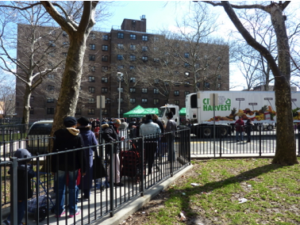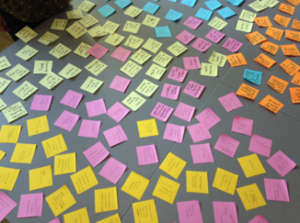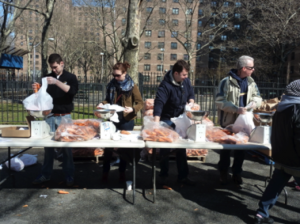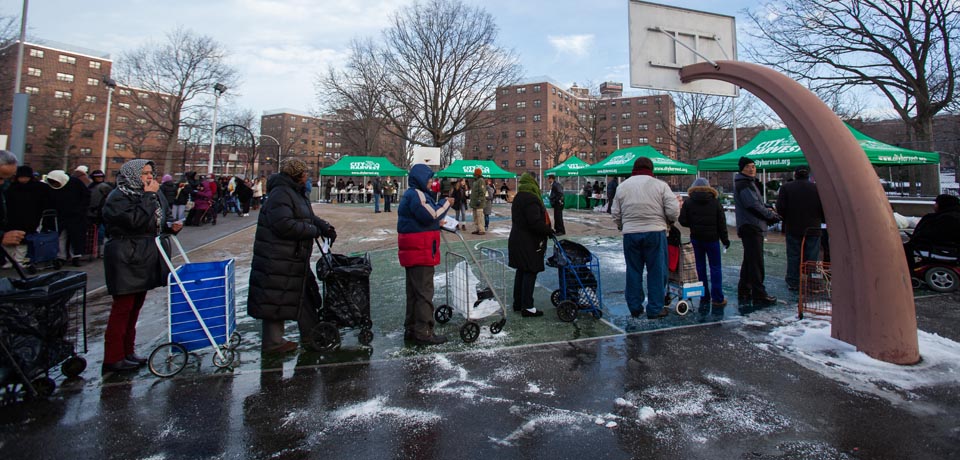Laura Vollmer, Nancy Pham, Sowmya Srinivasan, and Lauren Valdez worked for client City Harvest, an organization that provides Mobile Markets to rapidly infuse free fresh produce into five of the most food insecure communities in New York City. The team worked in Bed-Stuy, Brooklyn to redesign their Mobile Markets distribution process.
Every two weeks, City Harvest delivers thousands of pounds of free produce to hungry New Yorkers at their Mobile Market in Bed-Stuy, Brooklyn. We had the pleasure of working with this amazing NYC based non-profit organization during our semester in the Eat.Think.Design class at U.C. Berkeley. City Harvest’s Mobile Market program has been in existence for 10 years, and they distribute 16,000 pounds of free produce to about 400 people in 3-4 hours during at bi-weekly markets. City Harvest noted that all though their market was working, there are inefficiencies in their system and long lines for their clients, so they enlisted the help of our Eat.Think.Design team to apply the human centered design process towards making the Bed-Stuy  market more client-centric.
market more client-centric.
Our Design team for this project consisted of Laura Vollmer, Lauren Valdez, Nancy Pham, and Sowmya Srinivasan, and together we bring experience from the fields of Nutrition, City Planning, Public Health, and Medicine.
The Discover Phase
To understand the inefficiencies of the current mobile market, three of our team members visited the Bed-Stuy Market on April 6th. We spoke to clients in English and Spanish, and gathered their opinions and frustrations. We noted the clients’ appreciation for the food, but also their confusion in the registration process and line system. We also visited City Harvest’s offices and interviewed staff. including Leslie Gordon and Whitney Seiler, to get their insights on potential areas of concern. Meanwhile, in California we visited analogous markets in San Carlos, CA and Millbrae and learned from the clients there.
The Ideating Phase
 After gathering all of our information, we needed to transform our research into actionable insights. We had fun group meetups where we shared all the knowledge that we had gathered, and reviewed photos, videos and quotes that we captured these observations, gathering them into themes. Some of the themes we found were around staffing, volunteers, spatial arrangement of the market, gaining inspiration from other models of efficient produce delivery, and fixing disconnects in the system. Above all, we knew we had to preserve the mobile market values of client choice, respect, trust and community
After gathering all of our information, we needed to transform our research into actionable insights. We had fun group meetups where we shared all the knowledge that we had gathered, and reviewed photos, videos and quotes that we captured these observations, gathering them into themes. Some of the themes we found were around staffing, volunteers, spatial arrangement of the market, gaining inspiration from other models of efficient produce delivery, and fixing disconnects in the system. Above all, we knew we had to preserve the mobile market values of client choice, respect, trust and community
We used ‘how might we…’ questions to formulate specific questions, and we came up with over 191 ideas. We identified ideas worth pursuing by mapping our best ideas out on a 2×2 matrix and looking for the most impactful and feasible ideas.
The Prototyping Phase
After amassing a set of great ideas, we set out to prototype and test some of our solutions. We wanted to make some tangible prototypes to gather input. In order to reduce line wait times for clients, we thought some produce could be repackaged prior to market day into smaller bags. Our classmates liked clear and mesh bags for their transparency and handles, over brown bags, white plastic bags, and loose produce.
Other prototypes included creating a volunteer toolkit, as volunteer management came up as an area where a little more guidance could yield big results. We also created images of signs that could be used to direct people on market day. These signs can help new and returning clients find their way around the market, and reduce staff time to redirect people. We considered services for seniors and those with disabilities carefully, and came up with an idea of having pick-up sites for produce on days with inclement weather. We wrote suggestions of local agencies and churches near the Bed-Stuy mobile market who may be able to help out and hold the produce boxes for seniors to pick up.
Our very talented Nancy Pham created some bucket and box prototypes to attempt to standardize and expedite the weighing process for potatoes, onions, and carrots without having to use a scale. These pre-marked buckets that she created had a line marking 5 lbs of potatoes. We found by trial and error that only potatoes and onions worked well with this prototype. Carrots were difficult to measure in a stiff container.
Final thoughts
We learned a lot and made new friends from going through this design process. We were amazed to see that many of the problems we thoug ht we should address were not the ones that came out of the ideating phase of our process. By really listening to the clients and observing the market in action, we reframed and revised our initial impressions of the situation. This was a valuable lesson to us, as many problems in public health are approached in a top down manner – administrators identify issues to address. By incorporating our interviewing findings and observations into identifying problems, we were able to brainstorm and create solutions that can potentially have an impact for City Harvest’s continued Mobile Market expansion.
ht we should address were not the ones that came out of the ideating phase of our process. By really listening to the clients and observing the market in action, we reframed and revised our initial impressions of the situation. This was a valuable lesson to us, as many problems in public health are approached in a top down manner – administrators identify issues to address. By incorporating our interviewing findings and observations into identifying problems, we were able to brainstorm and create solutions that can potentially have an impact for City Harvest’s continued Mobile Market expansion.

